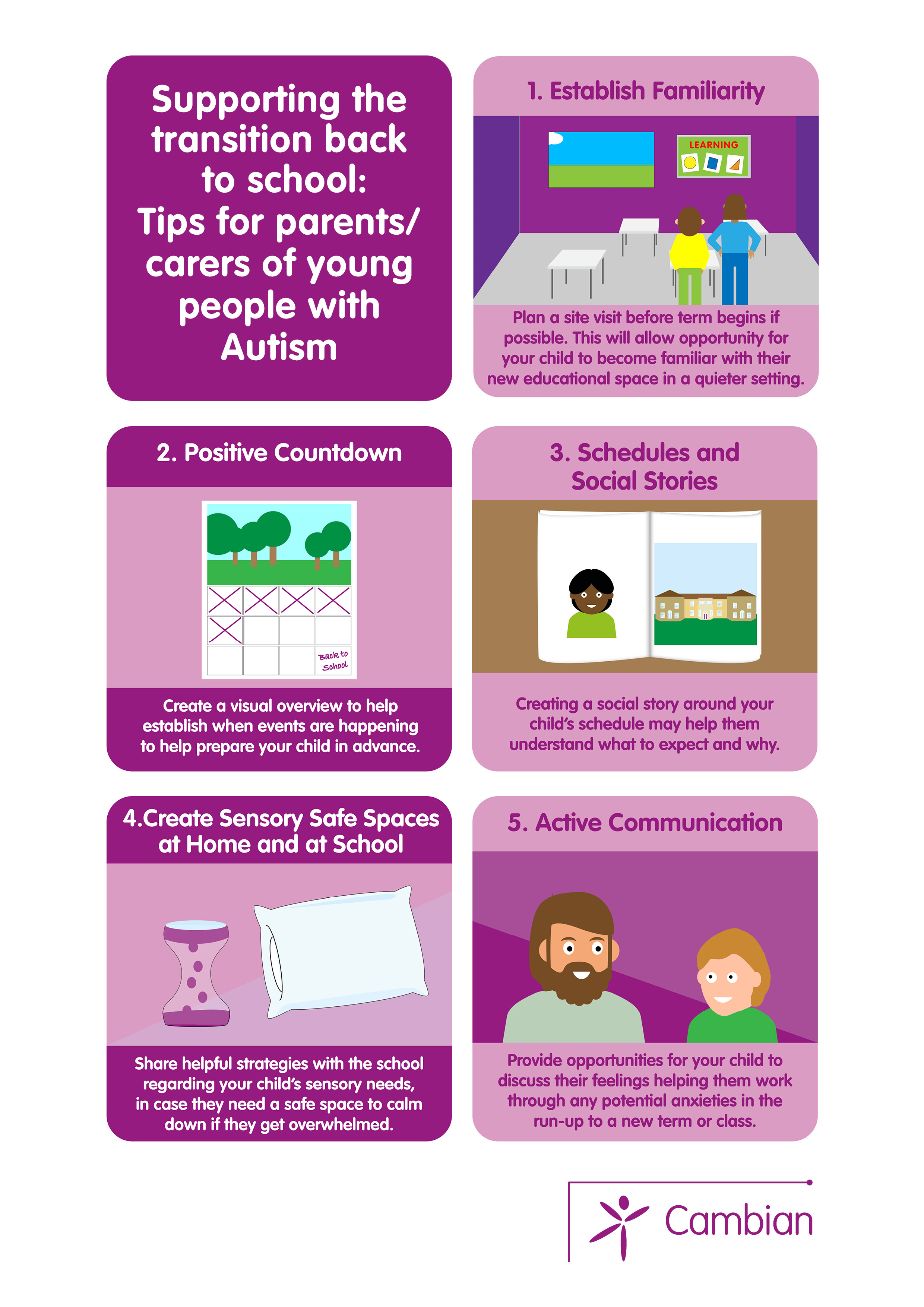As the summer holidays draw to a close and young people across the UK prepare to transition back to school or start at a new school, many will be feeling anxious or stressed ahead of the new term. This is especially true for young people with Autism Spectrum Disorder (ASD), many of whom often struggle with change, as ‘difficulties with transition’ may present as a symptom of their diagnosis.
At Cambian, we specialise in delivering individual programmes of learning to support young people with autism and complex needs on every step of their educational journey. Our schools and colleges pride themselves on their range of specialist support services within multi-disciplinary teams and by enhancing the learning experience for many of the young people we support.
With planning and preparation, it is possible to ease feelings of uncertainty and support a young person to transition back to school or to start a new at a new school. Here are some of our top tips:
1. Establish familiarity
Whether your child is starting at a new school, or transitioning into a new school year at the same school, allow some time for your child to become familiar with the new educational space in a quieter setting. Practice routes from the school entrance to the classroom, to the cafeteria and sports hall etc. If possible, meet with the teacher in advance, or ask for a picture so they are can recognise them at school.
Clare Gammons, Head Teacher at Cambian Wisbech School, adds that ‘it would also be helpful to document, and possibly get pictures and names of, every person your child will meet during the first few days of term, for example tutors and teaching assistants.
Pictures of key areas of the school such as the entrance, classroom, playground, cafeteria and art rooms will help your child become more familiar with their new environment.
In the case of moving to a new school, the school should be able to provide you with some positive comments from the children who are already in attendance; these can help to reduce anxiety and give reassurance. Visit the school’s website with your child and watch the video tour of the site together. You can break the viewing down into manageable chunks and write down any questions your child may have. Any questions you or your child may have can then be answered by the school quickly.
2. Positive countdown
Creating a visual overview of what is coming up will help establish a sense of routine and safety, and alleviate some feelings of anxiety your child may be feeling. Use a calendar, a whiteboard or any other visual means to plot out when events are happening to help prepare them in advance. Checking off days and events will also develop a sense of passing time and anticipation for starting a new school year.
Extending this calendar into the school term as much as possible will enable your child to get to grips with their new routine and orientate them on what their school days and weeks will look like.
Throughout the countdown, position the transition back to school positively. Emphasise how proud you are of your child and how school will support them to develop their strengths and work on their weaknesses. Encourage their wider support network to be involved in instilling a sense of excitement about the school year.
Samantha Campbell, Head Teacher of Cambian Spring Hill School advises ‘if your child is moving to a new school, and they hold transition/familiarisation days, try to attend one, even if it is only for a small amount of time. Inform staff of your child’s likes and dislikes so that they can couch their conversation with your child and begin to develop positive relationships.
3. Schedules and Social Stories
Schedules divide the day into manageable pieces. Identifying where, when and how various events will take place can make them feel less overwhelming.
Social stories are narratives which illustrate certain situations and problems and how people deal with them. They can be incredibly helpful tools to help those with autism understand behaviours and learn how to communicate with others.
Creating social stories around your child’s schedule will support them in preparing for school setting. In a social story a combination of narration, photos and drawings can be used to portray a specific situation. For example, if your child is anxious about entering their new classroom, your story could include names of peers in their class, where your child may sit, a picture of their teacher and ways to remember where in the school the classroom is.
Samantha adds, ‘if your child is transitioning to a new setting, show your child a copy of the school’s latest newsletter; these are often highly visual and celebrate many wonderful activities and have many photographs of happy children engaging in learning and having fun! You should be able to download a copy of the school’s newsletter via their website.’
4. Create sensory safe spaces at home and at school
During the summer holidays, you may have created a sensory-safe retreat space at home. Consider the auditory, visual, tactile and social preferences of the young person you support when creating a sensory-safe space. Designate a quiet area in the house or corner of a room house and try filling these spaces with different items such as comfortable pillows, visual oil timers, weighted blankets and fidget toys. Once term begins try to encourage your child to continue using their sensory-safe spaces as part of their new routine either before or after school to help them feel calm and grounded.
You understand your child’s sensory needs. Share helpful strategies with their teacher so that they are able to create a sensory-safe or retreat space in the classroom. The school’s clinical team will be able to offer you further advice regarding your child’s sensory diet so do not hesitate to contact them for further advice and support.
5. Active communication
Provide opportunities for your child to discuss their feelings, this will help them to work through potential anxieties. Many young people struggle to verbalise their feelings or may feel like you won’t understand. Ask them when they would like to talk about it and allow them time and space for them to approach you.
If your child is struggling to communicate face to face or are reluctant to write down how they are feeling, there are also digital tools available to help young people work through their feelings and log their thoughts, which may feel less intimidating to some. As part of the CareTech Group, we have access to Mind of My Own, an accessibility-driven, interactive app that allows the young people we support to record how they’re feeling in their own time and on their own terms on a platform they are familiar with.
Understanding how your child feels will allow you to best support them to back to school or into a new school setting. Remember, your child’s behaviour may change. They may become withdrawn and this is not unusual. Being a presence and actively listening can provide much reassurance.
It is also important to have open lines of communication with the school. Send an email, schedule a phone call or a pre-school conference with your child’s teacher to discuss your concerns and preferences and a support plan. Active communication with your young person’s educators will help them to provide the right support for your child.
Cambian Wisbech School has a well-established reputation for providing quality, personalised education for pupils ages 7-17 with social and emotional difficulties, along with associated challenging behaviours.
Spring Hill School is a residential and day school for children and young people aged 8-19 with a diagnosis of Autism Spectrum Disorder, associated challenging behaviours, learning and communication difficulties and complex needs.
Cambian is part of the CareTech Group, a leading healthcare provider delivering high quality, person-centred care and support to adults, children and young people with a range of complex needs. Our works spans across 550 services including education, residential and fostering.
For more information about our schools, or to speak to a friendly and knowledgeable member of our team, click here.


